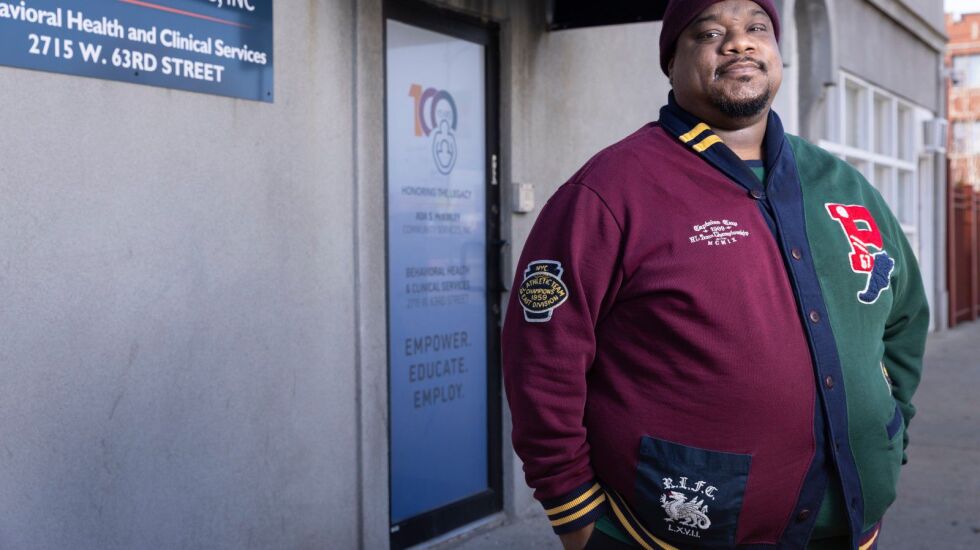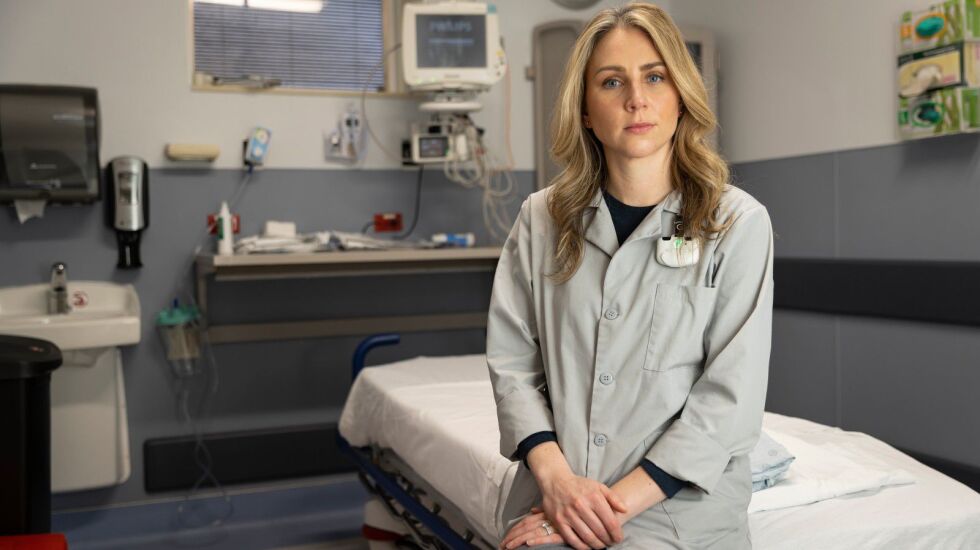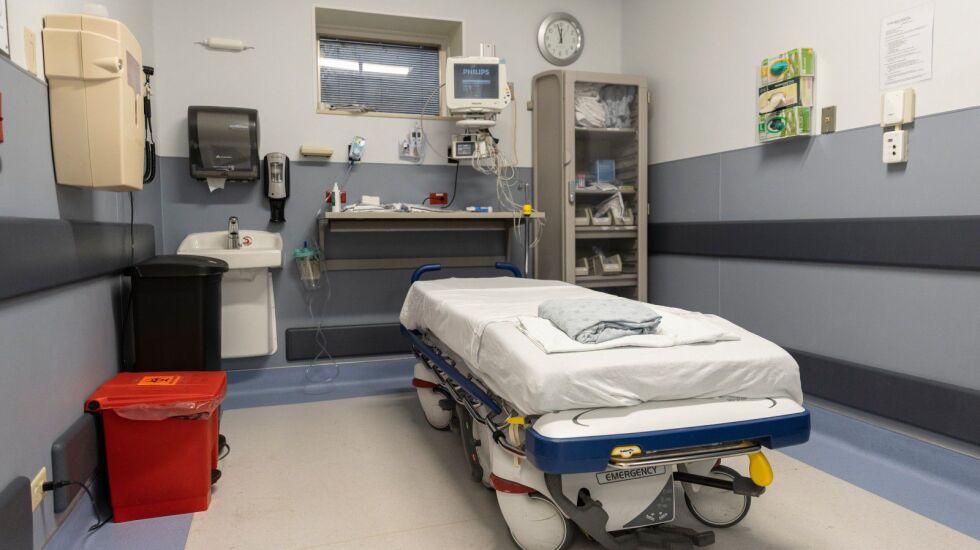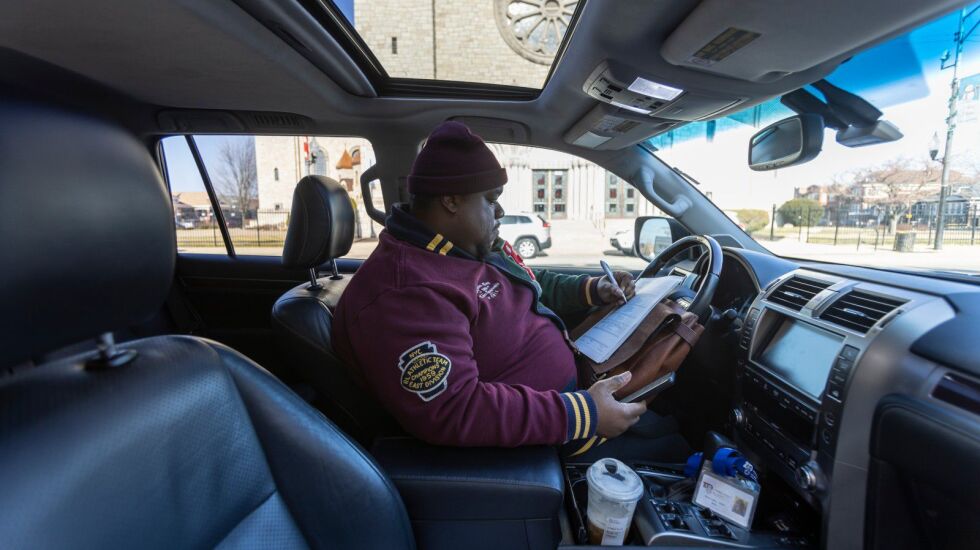
Randy Sadler, a paramedic of sorts for kids in emotional distress, sits across from the boy and says he has some questions. The boy’s dark brown bangs hang over his eyes. His mother and two adults from his school are there, too.
“Do you feel suicidal at this moment?” Sadler asks, telling the boy it’s OK no matter what his answer is.
He has in the past, the boy admits, but not right now.
Sadler probes a little deeper, knowing the boy told the counselor he had been suicidal. He asks: “Do you have a plan? Are you anxious?”
The weight is on Sadler to make a potentially life-or-death decision: Is this child safe to go home?
Every day in Illinois, specialists like Sadler are called in to schools, hospitals and homes to make these decisions. They’re on the front lines of the state’s child mental health crisis. Simmering for years, it’s been supercharged by the COVID-19 pandemic.
In Illinois, the percentage of children showing up at hospital emergency departments with suicidal thoughts rose nearly 60% over nearly six years ending in 2021, according to a study involving Lurie Children’s Hospital.
Twenty years ago, the state of Illinois developed a safety net for low-income children who face a mental health crisis and have Medicaid health insurance or no insurance at all. The state works with more than two dozen nonprofits, including Ada S. McKinley Community Services, where Sadler works, to try to quickly assess and find help for these children after a call is made to a hotline. The program is called Screening, Assessment and Support Services, or SASS.
Illinois mental health providers say the program offers families an essential lifeline.
But a six-month investigation by WBEZ has found that the state is failing to ensure that thousands of children get any follow-up help, let alone the type of intensive behavioral health support many need. Amid a youth mental health crisis and staffing shortages, the safety net is buckling. SASS workers don’t have enough places to send kids in distress.
“This is all being funded by all of our tax dollars, and it’s a total mess,” said Cook County Public Guardian Charles Golbert, who represents children in foster care, some who have gone through SASS.

Complaints that children in crisis are waiting hours just to get assessed under SASS — a response is required within 90 minutes — are up 50% in the past year, with about 46,000 SASS calls statewide that required a quick response, according to state records and data.
That’s even though state officials say they track and hold SASS providers accountable.
And state officials don’t even know whether all children in crisis screened by a SASS worker ended up getting connected with mental health support, typically inpatient or outpatient care, and whether they actually received treatment.
After months of being asked, state officials still didn’t provide screening outcome data for about 40% of the cases over five years that required the 90-minute response. More than 220,000 calls required a quick response during that period, from 2018 through 2022.
Illinois largely outsources the SASS program to private insurers with Medicaid contracts. State officials say they are just starting to hold insurance companies responsible for making sure that children have a follow-up appointment scheduled after a SASS crisis intervention or after a child is discharged from a hospital.
One-third of children seen under SASS have at least two calls made on their behalf in one year.
State officials say the Medicaid insurers follow these children closely.
Still, Kristine Herman, bureau chief of behavioral health for the Illinois Department of Healthcare and Family Services, which oversees SASS, and other state officials say they need to do better.
In December, the state launched a program called Pathways to Success that provides funding to organizations to provide more intensive care coordination and supportive services to children. Herman says she hopes this fills some holes in SASS.
Yet some of these services are what SASS providers — and the private Medicaid insurers — already are supposed to be providing.
The state has proposed spending nearly $150 million for Pathways to Success in the next budget year, starting July 1, and an estimated $300 million a year when the program is fully implemented.
“It’s one of the reasons why we’re pushing to get these additional services into the community,” Herman says, “because those are really the types of follow-up services that they need that they don’t have right now.”

That reality was painfully clear as Sadler was struggling last fall to decide whether the 13-year-old boy in the oversized shirt could safely go home.
Near tears, the boy’s mother explains through a Spanish interpreter that she’s run out of ideas about how to help her son. He’s been anxious for months, not sleeping and not wanting to go to school.
Sadler asks the boy, “What is making you so anxious?”
The boy says he feels pressure to grow up, to do well in school. After doing a thorough mental health assessment, Sadler says he’s going to recommend regular outpatient counseling. But he says, “There’s a waiting list.”
His agency, which covers most of the South Side and parts of the West Side, wanted to hire 15 to 20 more workers last fall but couldn’t keep up with the need.
Sadler tells the mother to call every week until they find a therapist.
“Call again and again,” he says. “Tell them that your son is not well. Do you understand? Be the squeaky wheel.”
Program was meant to be an equalizer
Sadler leaves the school frustrated.
“That baby needs someone to check up on him every day,” he says. “Ideally, that would be the school. But I get it. The school is under-resourced.”
The school counselor said he had no idea the boy was struggling. In a school of more than 900 students, the boy didn’t stand out.
Sadler looks at his phone. Another call. A school a few miles away has children experiencing what’s believed to be a mental health crisis.
Sadler is in his early 40s. But, when he speaks, he can sound like a worried grandma. He almost always calls children “babies” in an endearing way. He says parents, schools and hospitals want him to work magic for their babies, though there’s no magic to be worked.
“We are not the cure-all,” he says.
SASS is supposed to be an equalizer of sorts, helping to give kids from low-income families a better chance of getting mental health treatment without unnecessary hospitalizations.
Kids with private insurance typically have more doctors willing to treat them. This comes down to money: Private insurance tends to pay better.
WBEZ interviewed parents, school counselors and mental health providers around the state to see how this plays out.
A Chicago mother says turning to SASS turned out to be more hindrance than help. A year ago, her son had been threatening suicide.
“He started crying and saying he wanted to kill himself, that he didn’t have a point in life,” says the woman, Melina, whose last name isn’t being published to protect her son’s privacy.
His West Side school called SASS for help. For families with Medicaid, this is the main way to get urgent inpatient care. Melina says she was told it might take hours for a SASS worker to arrive. Not wanting her son to wait at the school, the mother, who didn’t have a car, took an Uber to pick him up from school and to a psychiatric hospital.
They spent five hours in the hospital’s waiting room. By the time someone arrived for the SASS assessment, the boy no longer was in visible crisis and didn’t say much. He and his mother were sent home with a referral for outpatient therapy.
“My head was pounding,” she says. “It was like a nightmare.”
Melina says she felt abandoned and scared: “He’s saying he wants to kill himself. Maybe he’s gonna do it. Maybe he’s not … I don’t know what to do.”
She told him to keep his door open while he slept.
When Melina called about therapy, she says she found waiting lists. Eventually, she landed a weekly spot for her son on her own. Still, she says she worries that her son isn’t getting enough treatment.

Chasing the same hospital beds
Once SASS providers assess children, the wait begins — for a bed in a hospital or a weekly therapy appointment.
Inside St. Bernard Hospital on the South Side, at least once a week a child in a mental health crisis arrives in the busy emergency room. This small community anchor doesn’t have psychiatric beds for adolescents or any pediatric unit at all. In all of the South Side, where there are vast health disparities compared with richer parts of Chicago, there isn’t one pediatric psychiatric bed.
So children wait at St. Bernard for days, sometimes more than a week, for a bed someplace else. Sadler is one of the crisis interventionists who works to get them placed. He’s a familiar face at the hospital, building rapport with the young patients.
Without anything to do, many children linger outside their exam rooms, hoping to strike up a conversation with staff members. They’re exposed to all of the trauma that’s seen in the ER — people who are shot, in labor or suffering heart attacks. They see police officers guard patients’ rooms.
Dr. Ashley Magda, a senior physician in St. Bernard’s ER, is frustrated.
“When will the government finally realize that, if we don’t help these kids as kids, we’re just going to have a bunch of very troubled adults?” Magda says.

What’s unfolding at St. Bernard is happening across Illinois. For the most vulnerable kids, who need immediate help, there are only about 30 hospitals in the entire state — about 15% of all hospitals — that have pediatric psychiatric beds. And not all take a large portion of Medicaid patients. Hospitals with the most psych beds for children are concentrated in the suburbs and near the West Side, according to 2020 state data, the most recent available.
As a result, children across Illinois are crisscrossing the state chasing the same beds, sometimes traveling hundreds of miles from their homes.
Kelsey Di Pirro, who works for Community Counseling Centers of Chicago, known as C4, paints a picture of the capacity crunch. SASS workers fax referral packages to hospitals all over Illinois to find a bed, faxing forms as far as Iowa and Tennessee. They do this every 12 hours until they get a bed. A child who winds up in Missouri will get there by ambulance but will need to find a way home.
Di Pirro says a child can wait in an ER for 24 hours to five days. In the past year, some have waited longer than a month.

“We’ve gotten to the point with some kids, the hospitals are, like, ‘We’re not going to accept them. Please stop calling us,’ ” says Carrie Ray of the Heritage Behavioral Health Center in Decatur.
Children with autism or aggressive behavior are hard to place. Finding a bed for a foster child is one of the biggest challenges. Hospitals want a commitment from the state that there will be a placement when treatment is finished. The answer often is that there’s nowhere for them to go. So these kids languish in the ER.
There’s no public real-time window into how many beds are actually available. Even the Illinois Department of Healthcare and Family Services, which oversees the SASS program, doesn’t have a clear picture.
Herman says the state brings together a team from multiple agencies to help stabilize children having trouble finding a bed.
State Medicaid claims illustrate how difficult it is for Medicaid patients in particular. Over roughly five years, one hospital and its providers submitted far more payment claims for treating pediatric Medicaid patients than another hospital with a similar number of beds — almost $37 million at one hospital versus around $2.5 million at the other, WBEZ found. In other words, one hospital is treating a lot of Medicaid patients. The other is not.
“It does not make me feel good when someone asks me, ‘What’s the race of the person,’ because it doesn’t matter,” said Melissa Coleman, a senior intervention specialist with Metropolitan Family Services, whose SASS territory covers the south suburbs and part of the South Side. “Some hospitals will ask you what the person’s ZIP code is. Why? I don’t even understand that part. And then they’ll ask you, ‘Which kind of [Medicaid] managed care is it?’ ”
The hospitals offer reasons they might not admit a child. Some cite a staff shortage — in rural areas in particular. That means taking on fewer patients if they have to staff private rooms or provide one-on-one monitoring. Others say how sick or aggressive a patient is are the main factors in whether they can be safely cared for in the hospital. In some cases, they say, this would place other patients at risk.
SASS crisis workers say the struggle to get children the care they need leaves them feeling defeated and angry — for the kids and also for the system they are a part of.

Struggling to find mental health care
It’s after 4 p.m. when Sadler gets a call from a West Side elementary school. A 12-year-old told a counselor he plans to kill himself with knives in his kitchen while his parents sleep.
Ada S. McKinley, which generally focuses on the South Side, expanded to the West Side when another provider left the SASS program. That leaves Ada S. McKinley doing West Side assessments by phone. The boy’s mother speaks only Spanish. So Sadler gets a translator on the call.
It creates an awkward situation: a vulnerable boy in an office with his mother and a counselor in a near-empty school speaking with two strange men on a speaker on a phone.
Sadler begins asking questions. The boy starts sobbing.
In a small, high-pitched voice, he admits wanting to kill himself. Then, he’s crying too hard to speak. The counselor says the boy had said he’s “getting sadder and sadder,” and: “Sometimes, I want to get out of this world and never get back.”
Sadler immediately decides the boy should be admitted to a hospital for psychiatric care.
The mother wants that to be at Rush University Medical Center, where her son previously was in an intensive therapy program. Also, it’s relatively close to home. But Rush no longer has a pediatric psychiatric unit. The school counselor says the best option is Riveredge Hospital in the west suburbs.
Sadler tells the mother the hospitalization could be for as long as 14 days.
Suddenly, the mother’s voice is shaking, and she is crying. Neither she nor her son wants this, she says.
Sadler steps in, saying he then would have to call the Illinois Department of Children and Family Services: “I need Mom to know … she has the legal right to say no. However, I will be immediately contacting DCFS, and someone will be at the home today, and this can impact her and if she has any other children as well.”
The counselor says the boy, listening, is becoming increasingly upset. Sadler tries to refocus the situation, saying, “The goal is to get him help.”
But the mom says she will look for help elsewhere. The counselor asks whether, at least, they should recommend that she remove any knives from their home.
“Remove everything sharp: knives, scissors and glass,” Sadler says.
Plans for fixes, but will they work?
State officials have known for years that SASS doesn’t deliver on its promises. In a 2019-20 report, an outside agency contracted by the state called for “immediate quality improvement efforts” related to children’s behavioral health, including SASS. Medicaid insurers have tried to improve by expanding access to treatment through telehealth and working with behavioral health providers to reserve appointment slots.
Gov. J.B. Pritzker, saying he wants more done for children, has tapped Dana Weiner, a senior policy fellow at Chapin Hall at the University of Chicago, to create a roadmap.

One recommendation is to launch a portal for parents to find which mental health services are available and where to find them. Pritzker put $10 million in his proposed 2024 state budget to create this. The idea is to eventually link families with the appointments they need.
Eventually, Weiner’s blueprint also would have any provider doing business with the state — from hospitals to community organizations — be transparent about whether it has beds or appointments available. Hospitals generally are loath to provide capacity information.
“We’ve been doing this as if it’s like a poker game where everybody has their cards, but … we can’t see what they are,” Weiner said in a presentation in December. “If we can see it, we can more effectively both distribute resources and work to get kids placed.”
She also wants more services to help keep children from ending up in a hospital.
Weiner envisions it would take three to five years to build the necessary workforce.
For now, the state is piloting Pathways to Success as a way to provide more support for children with serious mental illnesses, doing so in their homes and communities. Ada S. McKinley is one of the agencies that will offer the program.
Nestor Flores, the organization’s vice president, says he has been working on hiring and seeing that salaries are competitive.
“We are going to try to make sure that clients don’t fall through the cracks,” Flores says.
Sadler says he thinks this could end up providing additional services. But he worries that finding the staff for all of this will be hard. He has a long list of wishes — from schools providing more emotional support, communities getting more mental health providers, more hospitals with psychiatric beds in neighborhoods near families in need.
But he isn’t hopeful.
“The resources just aren’t there,” he says.
Contributing: Susie An, Kate Grossman







